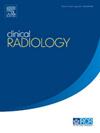Combining conventional magnetic resonance imaging (MRI) parameters with clinicopathologic data for differentiation of the three-tiered human epidermal growth factor receptor 2 (HER2) status in breast cancer
IF 2.1
3区 医学
Q2 RADIOLOGY, NUCLEAR MEDICINE & MEDICAL IMAGING
引用次数: 0
Abstract
AIM
To assess the three-tiered human epidermal growth factor receptor 2 (HER2) classification of breast cancer (BC) patients based on conventional magnetic resonance imaging (MRI) parameters combined with clinicopathologic data.
MATERIALS AND METHODS
211 patients with invasive BC were retrospectively evaluated and divided into the HER2-zero, HER2-low, and HER2-positive BC groups. Patients underwent conventional dynamic contrast-enhanced breast MRI. Radiologists assessed clinicopathologic features and measured the apparent diffusion coefficient (ADC) and haemodynamic parameters to differentiate HER2-zero/-low (n=129) from HER2-positive (n=82) BC (task 1) and then HER2-zero (n=90) from HER2-low (n=57) BC (task 2). Patients were randomly assigned to the training and test sets at a ratio of 7:3. Univariate and multivariate logistic regression analyses were applied to select the most useful predictors. Receiver operating characteristic curve analysis was applied to evaluate the discriminative performance of the models.
RESULTS
The ADC and Ki-67 status were independently associated factors both for task 1 (OR: 41.22, 5.68) and task 2 (OR: 0.02, 0.29). The models established combining conventional MRI parameters with clinicopathologic data in the training set for task 1 and task 2 yielded an area under the curve (AUC) of 0.836 and 0.874, respectively, and demonstrated effective prediction in the test set, with the AUC of 0.845 for task 1 and an AUC of 0.805 for task 2, respectively.
CONCLUSION
Models combining conventional magnetic resonance imaging (MRI) parameters and clinicopathologic data could be valuable for differentiating BC HER2 expression, which may aid in selecting patients for HER2-targeted therapies in those without fluorescence in situ hybridisation results.
将常规磁共振成像(MRI)参数与临床病理数据相结合,对乳腺癌中三层人表皮生长因子受体2 (HER2)状态的分化进行研究
目的基于常规磁共振成像(MRI)参数结合临床病理资料评估乳腺癌(BC)患者的人表皮生长因子受体2 (HER2)三级分类。材料与方法对211例浸润性BC患者进行回顾性评估,并将其分为her2 - 0、her2 -低和her2 -阳性三组。患者接受常规动态增强乳房MRI检查。放射科医生评估临床病理特征,测量表观扩散系数(ADC)和血流动力学参数,以区分her2 - 0 /低(n=129)和her2阳性(n=82) BC(任务1),然后区分her2 - 0 (n=90)和her2 -低(n=57) BC(任务2)。患者按7:3的比例随机分配到训练组和测试组。应用单变量和多变量逻辑回归分析来选择最有用的预测因子。采用受试者工作特征曲线分析来评价模型的判别性能。结果ADC和Ki-67状态是任务1 (OR: 41.22, 5.68)和任务2 (OR: 0.02, 0.29)的独立相关因素。在任务1和任务2的训练集中建立的常规MRI参数与临床病理数据相结合的模型,其曲线下面积(AUC)分别为0.836和0.874,在测试集中显示出有效的预测效果,任务1的AUC为0.845,任务2的AUC为0.805。结论结合常规磁共振成像(MRI)参数和临床病理数据的模型可用于鉴别BC HER2表达,有助于在没有荧光原位杂交结果的患者中选择HER2靶向治疗的患者。
本文章由计算机程序翻译,如有差异,请以英文原文为准。
求助全文
约1分钟内获得全文
求助全文
来源期刊

Clinical radiology
医学-核医学
CiteScore
4.70
自引率
3.80%
发文量
528
审稿时长
76 days
期刊介绍:
Clinical Radiology is published by Elsevier on behalf of The Royal College of Radiologists. Clinical Radiology is an International Journal bringing you original research, editorials and review articles on all aspects of diagnostic imaging, including:
• Computed tomography
• Magnetic resonance imaging
• Ultrasonography
• Digital radiology
• Interventional radiology
• Radiography
• Nuclear medicine
Papers on radiological protection, quality assurance, audit in radiology and matters relating to radiological training and education are also included. In addition, each issue contains correspondence, book reviews and notices of forthcoming events.
 求助内容:
求助内容: 应助结果提醒方式:
应助结果提醒方式:


